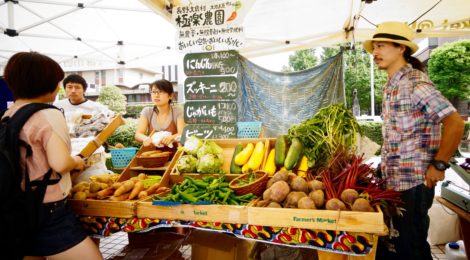
Japanese, eat local!
As final paper for the Wageningen University online course “Food Security and Sustainability: Food Access” (https://www.edx.org/course/food-security-sustainability-food-access-wageningenx-fssfax) I decided to write about the problem of food self-sufficiency of Japan. I targeted the Japanese population and I wrote a speech for a conference about sustainable food and agriculture held in Japan and attended by the civil society.
Japanese, eat local!
Japan is a country that gives a lot of importance to food. We can even say that Japan is a food-obsessed country (Barrett and Notaras, 2012). Food is often one of the primary motivators for many Japanese for travelling outside their hometowns. Food is always on TV and, at almost any time of the day or night, there is a show about food.
But Japanese food is not Japanese anymore.
Japan’s agricultural imports (5.8 trillion yen in 2014) make it the world’s fourth-largest importer, after the United States, China, and the European Union (EU) but Japan ranks lowest in terms of food self-sufficiency among countries with a population of more than 100 million (Ministry of Agriculture, Forestry and Fisheries-MAFF, 2013). Japan, in fact, is characterised by a strong decrease in domestic production that dropped from the 73% in 1965 to the 40% of today (data from Food Balance Sheet edited by the Ministry of Agriculture, Forestry and Fisheries of Japan).
That means that 60% of its food is supplied from abroad and that Japan is one of the least self-sufficient developed countries in the world.
The main reason of Japan’s low self-sufficiency is the fact that the diet of Japanese people changed significantly, leading to a lower consumption of rice, fish, soy and local vegetables but an increase in the consumption amount of livestock products such as meat that domestic agricultural production alone cannot supply sufficiently (Statistics bureau of Japan, 2015).
Another reason is that agriculture is a declining sector, characterized by small-scale farming and old workers (in 2010 the average age was 70). Farming is hard work and it is unclear who will replace the current generation of farmers when they retire as the farm is not, on the whole, a career destination for young Japanese. Consequently, the amount of food produced in Japan is in steady decline and the amount imported continues to increase (Barrett and Notaras, 2012).
This situation has made Japan chronically and highly reliant on food imports.
Japan’s reliance on food imports means that any ill-effects of global warming on food production could be felt keenly here (BBC, 2007). Moreover, low food self-sufficiency puts Japan at particular risk in the event that international food supplies are disrupted due to crises (The Japan Times, 2015). Finally instances of food contamination can severely impact the food security of Japan.
To tackle this problem one solution is that Japanese start to eat local again.
The Japanese Government has started a lot of initiatives to protect and continue the tradition.
For example it passed the Shokuiku (食育, food education) Basic Act in 2005 (Ministry of Agriculture, Forestry and Fisheries-MAFF, 2005) to try to maintain traditional cultural eating habits. However, this is not enough and there is still a lot to do.
Japanese, eating Japanese food again, you can play an important role in reviving your food culture and helping your country regaining a higher self-sufficiency rate.
So, Japanese start to eat local again! There are many reasons for which you should do that:
1) The washoku (Japanese cuisine) diet is healthy.
Japanese longevity is thought to be due in part to the nation’s healthy post-war diet of rice and fish.
Washoku is nutritionally well-balanced and thus contributes to long life and the prevention of obesity (The Japan Times, 2013).
Therefore, it is important to preserve and pass on the Japanese culinary culture to future generations
2) Local food is safe.
In the last decades Japan has experienced several food safety scandals but most of them concerned imported foods. As production networks in the conventional food system have become increasingly consolidated, and as distribution networks have become increasingly globalized, the risk of food safety problems (such as food-borne illness) has also increased.
Local food producers in Japan are committed to high quality and good taste. Therefore, it is safer to eat local products.
3) What food producers produce is not only food. They are the keeper of landscape and culture of the region, they are the teacher who can teach how to live along with nature, and their lifestyle and philosophy so different from cities give Japanese a valuable experience (Orizzontinternazionali, 2016).
Japanese take the future in your hands and start your food and agricultural revolution!
Bibliography:
Barrett B. and Notaras M. (2012), UN University, Future of Food in Japan. Accessed at: http://ourworld.unu.edu/en/future-of-food-in-japan
BBC (2007), Japan’s food crisis. Accessed at: http://news.bbc.co.uk/2/shared/spl/hi/picture_gallery/07/asia_pac_japan0s_food_crisis/html/2.stm
Ministry of Agriculture, Forestry and Fisheries-MAFF (2005), What is “Shokuiku (Food education)”?
Accessed at: http://www.maff.go.jp/e/pdf/shokuiku.pdf
Orizzontinternazionali (2016), 食べる通信 (TABERU TSUUSHIN): Change food, change the world. Accessed at: https://orizzontinternazionali.org/2016/05/18/yuki-honma-and-%E9%A3%9F%E3%81%B9%E3%82%8B%E9%80%9A%E4%BF%A1-taberu-tsuushin-change-food-change-the-world/
Statistics bureau of Japan (2015), Statistical Handbook of Japan 2015: Self-Sufficiency in Food. Accessed at: http://www.stat.go.jp/english/data/handbook/c0117.htm
The Japan Times (2013), UNESCO to recognize Japanese food culture. Accessed at: http://www.japantimes.co.jp/news/2013/10/23/national/unesco-to-recognize-japanese-food-culture/#.WK88km_hDIU
The Japan Time (2015), Nation’s food self-sufficiency rate. Accessed at: http://www.japantimes.co.jp/opinion/2015/04/01/editorials/nations-food-self-sufficiency-rate/#.WK9BEm_hDIU
(Featured Image Source: JamHouse)